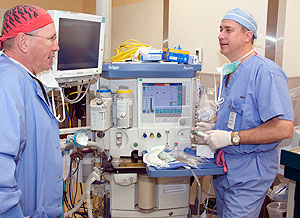When Daniel P. Gillen, M.D., gives orders, sometimes they go on a medical chart, and sometimes they’re more military in nature. You see, Gillen, assistant professor of anesthesiology and director of Trauma Anesthesia Services, is a doctor, and he’s also a brigadier general in the Air Force Reserve.
What began as a way to make medical school affordable eventually blossomed into a career.

“The primary reason I joined the Air Force was that they had a scholarship program,” Gillen says. “It was a year-for-year deal. I paid my own way for my first year of medical school, and then I joined the Air Force, and they paid for the next three years. After my residency training, I did payback for three years down at Maxwell Air Force Base in Alabama.”
But it didn’t end there. Interestingly, neither did his medical training. After finishing medical school at the University of Nebraska in 1982, he came to Barnes Hospital in St. Louis with a plan to go into urology, but he changed his mind and left for full-time duty in the military, where he worked as an emergency-room physician.
He then returned to Barnes for a residency in anesthesiology. An Air Force program for residents training in wartime-critical specialties, including anesthesiology, offered a monthly stipend if Gillen agreed to two years of reserve service for every year he spent in the program. A three-year anesthesia residency earned him six years of reserve duty. And he never left.
“I briefly was pulled out of my residency and deployed as an emergency-room physician during Operation Desert Storm from January until March of 1991,” he says. “Since I was an anesthesiology resident, they put me in the O/R quite a bit, and when I got back, I submitted the cases I had done, and they counted toward my residency. So I didn’t lose any time.”
He came back to St. Louis, completed his training and moved on to private practice at St. Elizabeth’s Hospital in Belleville, Ill. But some things tend to call a person back, things like the Air Force, the Persian Gulf and the Washington University Medical Center.
Rising in the ranks
At St. Elizabeth’s, Gillen was less than 10 miles from Scott Air Force Base, so he didn’t have to travel long distances for reserve weekends. He also met an Intensive Care Unit nurse named Patty, who would eventually become his wife.

“The anesthesia group was small, and in the ICU, we worked very closely with them, so we quickly knew the anesthesia docs by name,” Patty Gillen says. “It started as a working relationship. Then we began dating in 1995, and we got engaged in ’98.”
Reserve duty took up more time as Gillen rose in rank, earning his first command at Scott and later heading the 932nd Medical Squadron, also at Scott. And he spent time at the base even when he wasn’t participating in a UTA, military jargon for Unit Training Assembly, or reserve weekend. He was deployed back to the Persian Gulf in support of Operations Enduring Freedom and Iraqi Freedom as clinical director of 12 Critical Care Air Transport Teams, called CCATT in military parlance.
He both directed the dozen teams and served as a physician for one. CCATT teams are made up of three people: a critical-care physician — such as a pulmonologist, an intensivist or an anesthesiologist — an ICU-trained nurse and a respiratory technician. The CCATT teams routinely transport wounded soldiers who would be deemed too sick to be moved if they were in the United States.
“We started out in England, and when we would go on a mission, we would fly through Germany and down to Sicily,” he says. “Then we would pick up patients in Kuwait City and fly them to either Ramstein Air Base in Germany or to a Navy fleet hospital in Rota, Spain. Then we’d go back to England to wait for our next mission.”
During his deployment at the start of the war, Gillen not only was saving lives, but he was also worrying about what was happening on the home front. Patty was unable to have children, but she still had healthy eggs.
“We still wanted to have our own children,” Gillen says. “We made an arrangement that would give us three tries at having a child through surrogacy.'”
|
Daniel P. Gillen |
Born: Dec. 19, 1955, in York, Neb. Education: B.S., biology, 1978, Nebraska Wesleyan University; M.D., 1982, University of Nebraska Medical Center University position: Assistant professor of anesthesiology and director of Trauma Anesthesia Services Family: Wife, Patty Gillen; daughter, Kelly R. Gillen, 21; and sons Kyle P. Gillen, 14, Sean M. Gillen, 4, and Aidan C. Gillen, 4 |
The first two attempts failed. Then, in 2003, Patty’s sister, who also works at Barnes-Jewish Hospital, offered to be the surrogate. Shortly after that, Dan was sent to the Persian Gulf again.
“I kept e-mailing him the ultrasound pictures, so he could keep up with things,” Patty says. “And he did get back to the States twice during that eight-month period when he was deployed.”
He finally returned home in early November, and the couple’s twin sons, Sean Mikael and Aidan Carey Gillen, were born Dec. 3, 2003.
Gillen began adjusting to civilian life again in 2004. In 2000, Patty began managing the ICU at St. Elizabeth’s. Then she came to Barnes-Jewish Hospital to manage the 8300 Medical ICU in 2002. After returning from Iraq the following year, Gillen followed her back across the Mississippi River.
“There were malpractice problems in St. Clair and Madison counties in Illinois during that time, and many physicians were leaving, so the surgeons didn’t have as many referrals,” he explains. “With fewer surgeries, we had fewer patients to put to sleep, and the end result was that our anesthesia group split up. Patty was already working over here, so I interviewed with Washington U., and lucky for me, there was a position open.”
A crucial mission
He still has regular training with the Air Force Reserve, and these days, Gillen often is away for more than just his UTA weekends, but it hasn’t interfered with his career at Washington University and Barnes-Jewish Hospital.
“Dan’s extensive experience in managing trauma and mass casualties in Iraq has been an invaluable resource in creating a trauma anesthesiology program here at Washington University,” says Alex S. Evers, M.D., the Henry E. Mallinckrodt Professor and head of the Department of Anesthesiology.
There are reminders of Gillen’s military service around the medical center. In the medical intensive care unit where Patty works, there are several flags that were flown during his missions in Iraq, where Gillen returned to active duty last year. Instead of England or Germany as a home base, this time, he was deployed to Iraq itself, working as a CCATT physician and clinical director at Balad Air Base.
Independence Day last year brought him a mission that got him home for fireworks. It started July 3 when Sgt. Dan Powers was attacked on patrol outside of Baghdad. An Iraqi insurgent plunged an eight-inch knife into Powers’ head near his temple. The soldier remained conscious, unable to feel the knife, but his life was in danger.
Medics covered the knife with a Styrofoam cup and took Powers to a hospital in Baghdad, which, in turn, sent him to Balad. Neurosurgeons there removed the knife, but there was a lot of bleeding, and Powers needed more surgery. Gillen’s team then transported him all the way from Iraq to Andrews Air Force Base in the United States in a mission that included mid-air refueling of the C-17 medical transport plane.
“Anyone who has flown knows you have pressure changes, and we can only control those changes to a certain point,” Gillen says. “When you’re talking about a very serious head injury, you want to minimize those pressure changes, so we didn’t want to climb to altitude and then land a few times, so we had to fly the whole way from Iraq to Andrews.”
It was a 13-hour, nonstop mission, and as his plane took off to go back to Iraq, Gillen could see the fireworks exploding over the Washington Mall. But the real payoff came last October, when he attended a conference in Tennessee and met a healthy Sgt. Powers.
“In the past, soldiers like him would be dead,” Gillen says. “The patients we transport are very unstable. It’s been extremely gratifying, both personally and professionally, to both serve my country and bring these guys home.”